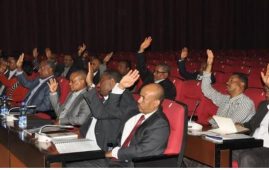[Quote from the study report]
“There is no resistance in communal work,” one focal group discussant asserted. “We can say confidently and boldly that there is no resistance even in this entire woreda [Endamehoni] and the whole Tigray region in mobilizing people for community work. We are in high spirits to participate in the compulsory free labor for community work; amidst the challenges we have, we work diligently.” They acknowledge that they have soil moisture and water conservation problems; it was therefore important to contribute their free labor. They believe that this generation must restore the ecology and ensure the maximization of production, thus “we give maximum labor and achieve maximum productivity,” another focal group discussant said. According to the farmers, they have been fully involved in the compulsory free labor initiative and also supported the idea. Twenty years ago the mountains were bare, but through committed and enthusiastic contribution of free labor for SWC [Soil and water conservation] these mountains have been conserved.
A research paper lauds mass mobilization of free compulsory labor for ecological restoration in Tigray state, northern Ethiopia.
The paper, authored by Tyhra Carolyn Kumasi and Kwadwo Asenso-Okyere for International Food Policy Research Institute (IFPRI), is based on analysis of “data collected from 20 villages in 3 districts in the Tigray region through a household survey using a structured questionnaire, focus group discussions, and personal observations”.
This paper answers some pertinent questions about mass mobilization of free compulsory labor for ecological restoration in Tigray. It details perception of changes in climate; the process of collective decisionmaking; resistance, documentation, and enforcement of rules; methods of conflict resolution; knowledge and information networks; arrangements for benefit sharing of communal resources; and the role of gender in mass mobilization for communal work.
The study found that a high degree of support and participation in the scheme it calls “mass mobilization of free compulsory labor”. This same scheme is reffered to as voluntary public mobilization by the government, while western NGOs like Human Rights Watch decry it labeling it “forced labor”.
The study paper reported that:![[Tigray - Ethiopia] mass mobilization of free compulsory labor for ecological restoration [Tigray - Ethiopia] mass mobilization of free compulsory labor for ecological restoration](https://hornaffairs.com/wp-content/uploads/2012/05/tigray-ethiopia-mass-mobilization-of-free-compulsory-labor-for-ecological-restoration_thumb.jpg)
Most respondents (77.8 percent) had not observed any form of resistance to compulsory free labor for community work because they considered the land as their own.
However, there were instances when very poor farmers who did not have anything to eat went to their private farms to work. Nevertheless, these farmers believed that the area must be conserved and thus saw the need for free labor mobilization for community work. Most of the people were happy to work and there was also a local bylaw that stipulated that anyone who absented himself/herself from community work due to travel to another tabia would be punished with a heavier workload than is usually accomplished in a day. Absenteeism due to sickness, pregnancy, or traveling to another tabia for a funeral was not considered a form of resistance to community work. The sick were required to provide evidence from a doctor, otherwise they were penalized.
During conflict resolutions with reference to any form of resistances, the community employed mediation through discussions with the entire community (38.8 percent), through the use of group elders in a conflict resolution committee (30.3 percent), through the use of the bylaw as a point of reference in a local court (16.4 percent), and through the involvement of the peasant association (14.5 percent).
The motivation of the participants in the mass mobilization were described by the study as follows:
Respondents (99.6 percent) who contributed labor for communal work did so for a period of 20 days per year during the dry season so that it did not conflict with farm work. Approximately all the respondents (97.3 percent) considered the restoration of the ecology as a benefit they derived from compulsory free labor for community work. Approximately all (99 percent) of the farmers interviewed from the study tabias [district] felt inspired to offer their free labor for community work. The motivation for the work included improvement in their livelihood (43.2 percent), increase in foodcrop production (36.3 percent), and possible increase in groundwater availability (19.5 percent).
While about 45 percent of the respondents “did not think they faced any challenges in participating in compulsory free labor for community work”, the study indicated that more than half of the respondents mentioned “various activities that conflict with communal work, including domestic work (21.8 percent), taking care of livestock (19.3 percent), and other business activities (13.1 percent)”.
The study paper credited social networks, including development groups and men, women, and youth associations, for the success of the mobilization. In addition to the history and homogeneity of the people of the region. The paper noted:
The existence of institutions in terms of grassroots organizations and rules and regulations with appropriate sanctions were major factors in the positive response to the call for community action in Tigray. The community was structured and organized into development groups and men, women, and youth associations. These community organizations played a vital role in mobilizing their respective members for compulsory free labor. During communal work, the developmental group leaders, tabia heads, work group leaders, and officials of the Bureau of Agriculture were in control of the organization of people and tasks, and ensured that the work was carried out. We also observed that the strong institutional and organizational developments were linked to the strong Tigray People’s Liberation Front (TPLF) insurgency campaigns against the Derg regime and later the commitment of government at the national, regional, and local levels.
The homogeneity in the community in terms of ethnicity and religion played a major role in ensuring trust among the people and promoted successful group cohesion and cooperation. We observed a docile society that was enthusiastic to take on community activities to restore their degraded ecology, and this may be due to the connection of the people to the Orthodox Church of Ethiopia. All of these factors contributed to the near absence of resistance to the call to contribute 20 days of free labor per year to ecological restoration for SWC and the establishment of woodlots and grazing grounds.
In conclusion, the the paper underlined that:
We conclude that commitment of people to communal activities like ecological restoration can be sustained if there are appropriate local- and national-level institutions, support systems, and policies related to rural development. As it is done in Tigray, both men and women should be fully involved in the planning, mobilizing, organizing, providing leadership, resolving conflicts, and sharing communal products related to communal activities involving the whole citizenry. Such involvement of the whole community in all aspects of the community mobilization and the ensuing collective action promotes gender equity in the local communities and engenders positive responses to the call to act together to tackle community problems.
The case study in the Tigray region has illustrated how social networks and power relations are unique for each kushet [Villages] and require appropriate methodological adaptations in research and development approaches. Social connectedness in the kushets is an important resource that should be taken into account by development agents, extension workers, and advisory services in the dissemination of knowledge and information on climate change and community mobilization.
* You may download the study report, titled “Responding to Land Degradation in the Highlands of Tigraÿ, Northern Ethiopia”, dated Dec. 2011 (but released this month) here (link).
*******************
Check the Agriculture archive or the Human Rights archive for related posts.






A different type of bonus could be the variable benefit, this indicates you gat a specific percent in the sum people deposit. The percentage differs for each and every site – it might be 20% as well as 50%. Some casinos even give you a 100% casino bonus. This can be a way for getting people back in the personal game suites, but a good online casino bonus means that you have to play through some rules especially when you want to redraw your money. This is difficult because once you get a good online casino bonus you need to meet many conditions that happen to be not quickly accomplished. On the other hand, your efforts is going to be rewarded.